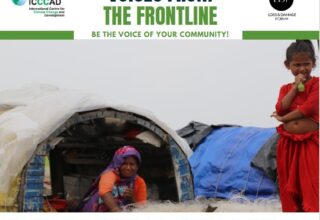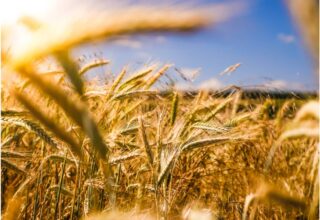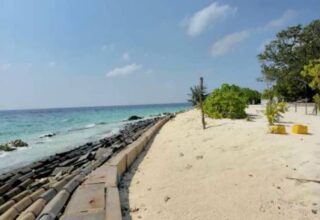In Korail, one of the largest informal settlements in Dhaka, Bangladesh, a group of gardeners expanded their gardening practice during and after the coronavirus-related lockdown. Dipak Bhowmick and Nusrat Bijoya report.
This is the forty-second in the series of stories from Voices from the Frontline initiative by ICCCAD and CDKN.
Korail is one of the largest informal, low-income settlements in Dhaka. Located in Ward no 19 and 20 of Dhaka North City Corporation (DNCC), it has existed now for many decades. Although Korail itself has the potential to function as a city, there is no concrete plan for its governance and provision of services to the community. It also lacks a formal supply of water. Existing power dynamics and political influences are further complicating the situation and the prospects for these marginalised communities. During Covid-19, social insecurity as well as economic hardship has put members of the community in a more miserable condition than before.
Over the last two years, the adjacent lakeside community of Korail has found a novel way of using urban land on the periphery of the lake (which totals approximately 8500+ square meters) to grow vegetables and fruits. The land is the result of a RAJUK (city development authority) initiative to extend roads demolishing adjacent structures.
Experiences during the lockdown
Lockdown was decreed in Bangladesh from 26 March, 2020 in the name of “general holidays” and continued till 31 May, 2020. Throughout this time, community members panicked about the spread of Covid-19. At the same time, they were worried about food and financial security. Many of them also left for their home towns and villages, as they saw no other option. Many land owners forced community members to leave as they were unable to pay rent.
“The term lockdown was translated as ‘shadharon chuti’ (general holiday) in all government declarations, which created a lot of confusion in terms of what would happen and what we were allowed to do. The fear of assault by the police kept residents inside their homes. We didn’t know much about the outbreak of the pandemic,” says Nazma Begum, a resident of Korail slum.
Some families had to cut down on household food intake and change their dietary habits. Some even starved for days as they couldn’t go out and there was a shortage of food supply. Unavailability of fresh food and vegetables and price hikes made the situation even worse. Bokuli Begum, another resident of Korail stated that, despite being physically able, her husband’s unwillingness to work put her family in an adverse situation. Finding no alternative option available, she and her son Rakib knocked at the doors of community leaders to find assistance.
Rakib was able to manage some assistance for a short period but that wasn’t sufficient for the long run. “Rich people waste their food but don’t share it with poor people like us. During Covid they didn’t even remember us,” says Sokhina Khatun, a resident of Korail.
Urban farming to ensure food security
Seeing the worsening food shortage, some far-sighted community leaders took up the initiative to expand their urban farming practice. Initially Dhaka North City Corporation (DNCC) wanted to clean up the land and get rid of them, but the community members protested and eventually obtained permission.
Paraa, a design and architecture studio working on enhancing the spaces within local communities in Bangladesh, acted as a bridge between urban poor farmers and power practitioners. UN-Habitat also provided some seeds (with a net worth of 50,000 BDT) and Paraa delivered them among the practitioners to help them grow their own food.
The residents of the Korail community had no clear idea about which areas of land were permitted to be cultivated and by whom, and often one household’s lands were occupied by neighbours. Paraa conducted a field survey, plotted households’ lands, introduced a digital database management system, and gave each household a specific identification number so that each one can easily recognise their plot.
Community members welcomed the approach and expressed their gratitude for mapping their lakeside community farming practice. In their opinion, the concept of an integrated lakeside map of farming practice will reduce confusion and overlap among activities, and will also help them receive resources from other organisations.
The lakeside residents organised themselves to cooperate and collectively manage their urban gardening practices. They are currently working in groups and each group comprises 5 to 10 farmers who share a chunk of land, manage, and secure their plots, distributing roles and products. This way there is always someone to look after the plots and manage resources efficiently.
The practice features a diverse cropping strategy, which optimises both the nutritional value and productivity of the plots. The farmers design and allocate their plots for growing a variety of leafy and root vegetables, and spices and fruits on creepers, vines and trees. They mix produce that is seasonal with perennial varieties. Seeds are also sourced from local stores and many of the practitioners use pesticides, when needed, in certain seasons.
Since the practice is lakeside-based; they extensively use lake water, and benefit from the lakeside soil, which is highly cultivable. This comes with a disadvantage, which is that farmers must adopt changes in production strategies, depending on seasonally-variable water levels .
The neighbouring residents have been cooperative in terms of resource sharing and in turn benefitted by making fresh vegetables available to them. But there has been no notable support rendered by the local government or municipality as expressed by the growing community.
One of the major outcomes of the practice has been the active participation of women community members as they could easily work on the adjacent lands near their home and take care of their children at the same time. One third of the lakeside farmers are women, who are directly engaged in growing, managing as well as coordinating the collective activities. Many of them have already shown their capacity and courage to lead an organised farming initiative. If trained, they could potentially be capacitated as urban farmers and empower themselves which is necessary to transfer and scale up the practice.
The practice inspired several others among high income residents who are also growing at the household level, not necessarily to meet consumption needs but understanding the demand for fresh produce and the joy in cultivating. The practice which is currently concentrated to one-fourth of the potential cultivable area could be transferred throughout the entire Gulshan-Banani lakeside, a scale that is four times bigger than the ongoing initiative.
Interviewer’s Perspective
Urban agriculture has emerged as an effective solution for residents of the informal settlement of Korail to increase their food and economic security. But due to land tenure insecurity, the continuation of the process, in the long run, is still at stake. They were not prepared for this lockdown and still don’t know what awaits in the upcoming days. They are expecting help from the government, NGOs, and other organisations in the form of direct employment, training, or learning new techniques for building their capacity. Korail community women identify financial security as their most prominent issue; and they also identify socio-political insecurity as a potential barrier to be addressed if they are to escape from their poor socioeconomic condition. From their point of view, only providing money is not adequate because they don’t know how and in which way, they will use the money to change their condition. They suggested that money with guidance on cultivation techniques is all they need at this moment. They are expecting a sustainable solution so that soon if something happens as COVID or the effect extends, they may be well prepared for any hostile situation.
About the Interviewer
Dipak Bhowmick is an Urban Planner at Paraa, and studying for his Masters in International Relations at Dhaka University. Nusrat Bijoya is currently pursuing her Masters in Urban and Regional Planning at Jahangirnagar University. The interviews were done by Paraa, an architecture, design and urban research studio based in Dhaka and London.
About the interviewees
Bokuli Begum, Sakhina Khatun, Mst. Ohida, Nazma Begum, and Selina participated in the interview and they are all within the age group 30 to 60 years. They have been living in the Korail slum for more than 25years.






